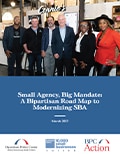Goldman Sachs 10,000 Small Businesses Voices (10KSBV) has released a new report in partnership with the Bipartisan Policy Center – Small Agency, Big Mandate: A Bipartisan Road Map to Modernizing the SBA.
America’s small business owners deserve a modern Small Business Administration (SBA). It’s been 23 years since Congress last reauthorized the SBA, providing the critical review and creation of resources necessary to effectively serve America’s small business community. The result: programs and systems that haven’t kept up with the needs of today’s small businesses.
There are three core areas that policymakers must address to create an SBA that works for today’s small businesses:
Access to Capital
Key Focus: Close small business financing gaps across race, gender, age, and geography to help small businesses reach their full economic potential
- Accessing capital is a persistent problem for small business owners. There are glaring gaps in the ability to access credit depending on the age of the business, the size of the loan, and the business’s location. Securing financing is especially difficult for women business owners, business owners of color and other underserved groups including rural small businesses.
- SBA lending is important to ensuring all entrepreneurs have access to flexible and affordable credit so they can start and expand their businesses. But according to 10KSBV survey data, 42% of small business owners rate the effectiveness of the SBA’s access to capital programs as “poor,” and just 29% rate them “excellent” or “good.”
Proposed Solutions
- Clarify the mission – Create a uniform definition of a “microbusiness” for purposes of SBA capital, procurement, and counseling programs.
- Expand microloan programs – Make microloans more accessible by allowing intermediary institutions to offer lines of credit to small businesses, placing limits on repayment terms, and reserving a portion of new loan funds for states with a dearth of microloan providers
- Leverage existing investments – Permit investment of federal dollars in Small Business Investment Companies (SBICs), beginning with funds from the State Small Business Credit Initiative (SSBCI).
- Solve for small business priorities – Expand allowable uses of SBA guaranteed loans to cover the provision of child care services to employees.
Government Contracting
Key Focus: Improve small business participation in the federal procurement marketplace
- Federal contracting can be an important opportunity for small-business owners—if they can get a contract or become a subcontractor. The procurement process can be confusing and tedious, and the SBA has limited tools to guide entrepreneurs through it or hold federal agencies accountable for meeting small business procurement goals.
- The federal government is required to award 23% of annual direct contract dollars to small businesses and has separate goals for underserved subgroups such as women owned businesses. Agencies often do not meet these goals, or they double-count contracts against multiple set-asides. As a result, the number of small businesses entering the procurement marketplace declined by 79% from 2005 to 2019.
- In 10KSBV survey data, 40% of small business owners rate the effectiveness of the SBA’s procurement assistance programs as “poor,” and just 15% rated them “excellent” or “good.”
Proposed Solutions
- Streamline contracting opportunities – Raise sole source and simplified acquisition thresholds.
- Simplify certification – Streamline small business certification programs through one central system.
- Improve the quality of data collected and reported – End the practice of “double-dipping” or counting agency performance against multiple subcategory goals.
- Enforce fair terms – Ensure small business subcontractors are treated fairly and paid on time by large prime contractors.
- Advocate for small business across government – Provide the SBA with sufficient resources to ensure that contracting officers across agencies are well versed in Federal Acquisition Regulation.
- Invest in small business education – Bolster outreach and technical assistance to expand the number of new businesses entering the procurement market.
Entrepreneurial Development and Counseling
Key Focus: Support 21st Century small business development as effectively as possible
- The landscape of entrepreneurship has changed significantly in the last 20 years. There are many more small businesses, more businesses owned by women and minorities, and more small business support programs. Amid this rapidly expanding landscape, SBA programs should adapt, digitize, and fill the market needs unaddressed by others.
- Clarity about resources can make the entrepreneurial journey less of a maze and more of a roadmap. Unfortunately, 85% of small business owners give the government a C-grade or below for its marketing and communication about the essential resources and services are available.
- To this end, 95% of small-business owners express support for developing a 21st-century marketing and communications strategy to bring more awareness to the resources available to small businesses.
Proposed Solutions
- Strengthen customer service – Update technology, systems, and processes to shorten the time small business owners wait for responses, and to minimize time-consuming requests to resubmit information.
Improve marketing – Allocate dedicated marketing resources to SBA district offices to help them put their local knowledge to use in improving outreach to small businesses. - Modernize programs – Ensure technical assistance and training programs address today’s business issues, including the growing array of digital tools available to help small businesses grow.
Reflect the diversity of America’s small businesses – Update the SBA’s current mentoring model to a coaching model that reflects the diversity of today’s small business owner population.

Small Agency, Big Mandate: A Bipartisan Road Map to Modernizing the Small Business Administration
Read ReportView our 2022 Report: From Pandemic to Prosperity: Bipartisan Solutions to Support Today’s Small Businesses here.



